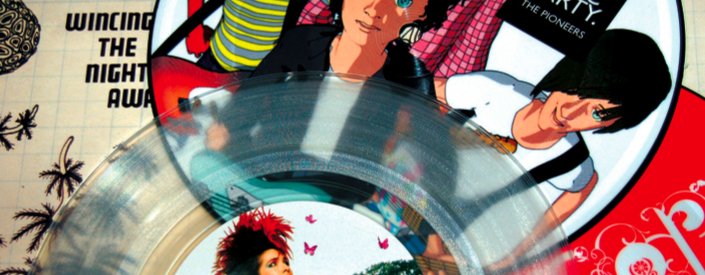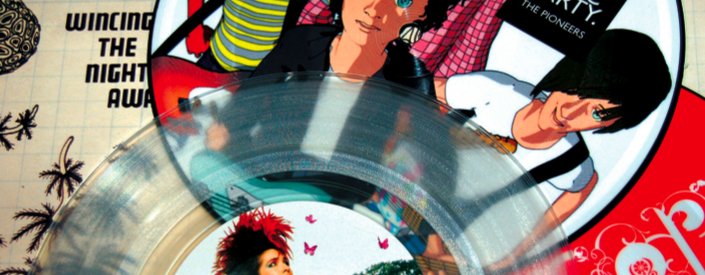 Vinyl records, you say? Didn’t they die out around the same time as your dad’s hair?
Vinyl records, you say? Didn’t they die out around the same time as your dad’s hair?
The evolution of the music medium (from the cassette to the CD to the almighty blip that was the mini-disc to the mp3 and now to the USB stick) ensured that vinyl died a quiet death in the late Eighties and early Nineties, whilst no one but audiophiles and DJs mourned its demise. However, a revival is on the horizon for the vinyl record, with UK music fans discovering its inherent coolness all over again. Against all odds, the LP crate is back. Sadly, the same can’t be said for your dad’s bald patch.
As with any revolution, it’s important to consider its past. So first, children, a brief history lesson. The record was created in 1888 by an ingenious fellow named Emile Berliner. The German-born, American-based inventor’s design introduced the now familiar flat disc format, but in rubber instead of plastic. Vinyl didn’t come into production until our American friends decided they needed a more durable material for records transported overseas to US troops in World War Two. At this time, vinyl was still costly to produce and not the throwaway commodity it is today.
Vinyl’s golden age undoubtedly came in the Sixties and Seventies when the 7″ single (or 45 as it was known back in the day) dominated the market. By this time, records and portable record players were inexpensive to produce and so record sales soared, peaking in the late 70s when almost 89 million 7″ singles were sold each year. Sadly, all good things come to an end, and the death knell eventually rang for vinyl with the emergence of the cassette tape and later the CD, formats that were cheaper to manufacture and more portable.
Fast-forward a decade or two to today, where mp3s and CDs co-rule the music roost. According to British Phonographic Industry (BPI) statistics, UK music consumers are the biggest CD-buyers per head in the world and have the highest ownership rates of iPods and other mp3 players (so that’ll be what the student loan went on). At this point, you may well ask, if we’re all so dotty about downloads, where’s this vinyl renaissance?
It appears that over the last twenty years, vinyl has been biding its time, waiting for us to become disillusioned with the mundane, disposable CD and the tinny tedium of the mp3. It has been holding out for a time when we would all be looking for something ‘new’ and, well, a bit more fun. It seems that time has come. Although the vinyl volcano was lying fairly dormant in 2000 with just 200,000 annual sales, it finally erupted last year when, according to the Official Charts Company (OCC), sales rose to over 1.1 million. This trend is only set to increase in the foreseeable future, with 7″ single sales up by 12.9% for January-June this year alone (BPI). So, with vinyl set to be the music lover’s medium of choice, the big question is, why?
A big part of the resurgence of vinyl as a format is simply that more bands and artists are choosing to release their material on it (The White Stripes’ Icky Thump being this year’s biggest selling vinyl so far, fact fans). It seems that every rock star and his brother is vinyl-centric these days, with some even getting behind the decks at after-party venues and club nights whilst on tour (Arctic Monkeys’ sticksman Matt Helders being a notable example). Meanwhile, the not-unrelated resurgence of retro-cool is perhaps the reason why record players are again widely available on the internet and high street, with even Argos getting in on the indie action. And it isn’t just old-school gramophones – DJ decks are now more affordable than ever, with some models being USB-compatible, enabling you to transfer the superior sound of vinyl to your laptop and become the world-class bedroom DJ you always knew you were.
True, vinyl is still a market featuring predominantly indie/alternative artists, but this scene itself has experienced a renaissance of sorts in the new millennium. It has seen a plethora of quirky new bands and sub-genres (post-hardcore trance folk, anyone?) inundate the scene. Whether you think this has had positive results (The View, Klaxons, MIA, Jamie T, Gallows) or negative (let’s just say Fall Out Boy), it has enabled indie/alt bands to spill over into the mainstream, and they’re bringing vinyl with them. New acts in particular are embracing the LP, releasing etched editions, picture discs, vinyl-only B-sides and limited editions. London songstress Adele, currently receiving the adoring attentions of the music press, released her debut single ‘Hometown’ on a limited pressing of 500 only. A veritable frenzy ensued, with many fans resorting to eBay just to get their hands on a copy.
There is also sense of alternative-cool about the vinyl record that fits with the indie ethos. It may be the warmer, richer sound achieved on vinyl; the fact that you’re not only buying a record but the artwork that comes with it; or simply the enjoyment of actually going out and looking for that 7″ that appeals to a generation who seem to be tiring of the clinical process of downloading music. It is now even easier to acquaint yourself with vinyl, as many high street music stores, such as HMV, are recognising the vinyl trend and featuring records more prominently in their stores.
However, a bit of advice is in order, young vinyl grasshopper: try not to buy it from these places. They invariably only stock mainstream releases, and the staff (although perfectly trained in customer service, aka the chip and pin machine) won’t have the same in-depth knowledge of vinyl and can’t personalise the experience like staff in an independent record shop. Glasgow is home to a great selection of them, Monorail and Volcanic Tongue being the cream of the vinyl crop. Record shops and fairs can seem a little intimidating at first, but persevere and you could emerge four hours later with a gem of a record by a band you’ve never heard of but will undoubtedly love forever.
So how do we account for this vinyl Second Coming? Perhaps it’s a generation of budding turntablists, or that ‘old’ often becomes ‘vintage-cool’, or the simple joy of putting a record on the turntable and hearing the crackle of stylus on vinyl. Whatever the reason, it can only be a good thing, and as a self-confessed vinyl geek, I promise that once you’ve experienced the euphoria of finding the record that you’ve spent countless days, weeks and hours looking for, you’ll wonder why they ever went out of fashion in the first place. Embrace your inner audiophile and ditch the download. Vive le Vinyl!

